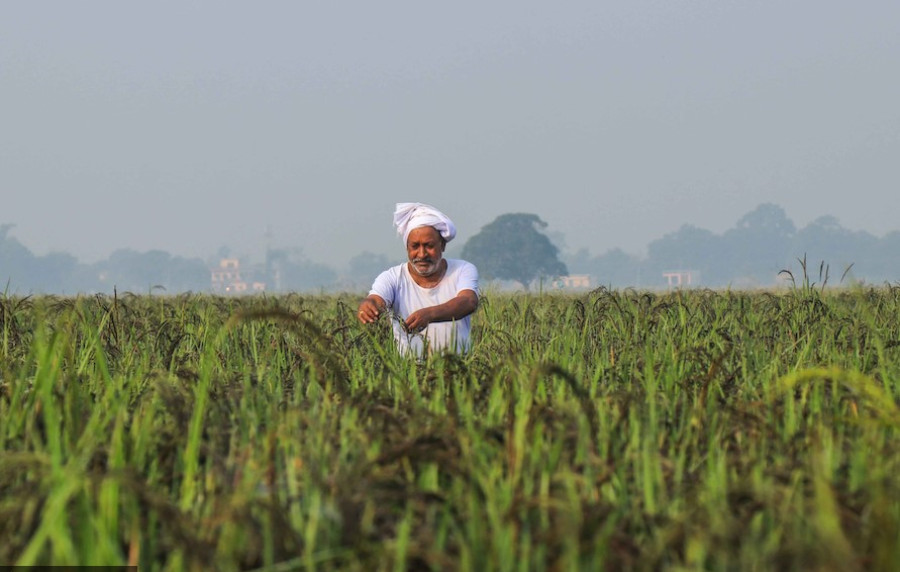Columns
Where does the agriculture budget go?
Sub-federal levels should better manage agriculture as they are closer to the farmers.
Khim Lal Devkota
As per the Constitution of Nepal, sub-national governments—provincial and local—are in charge of agriculture. Specifically, provinces are mandated to manage agriculture and livestock development, while local governments hold exclusive authority over various areas such as agriculture and livestock farming, agricultural production management, animal health, agricultural roads and related matters. However, agriculture isn’t under the exclusive jurisdiction at the federal level. Instead, it is included in the concurrent list shared by all three levels of government. It is essential to understand that exclusive rights prevail over concurrent rights.
A few weeks ago, the Ministry of Agriculture and Livestock Development (MoALD) published data on the total grants allocated to various people and groups in the agricultural sector over recent years. According to the report, from fiscal year 2019-20 to 2023-24, Rs107.66 billion was allocated to MoALD. Despite the constitutional mandate entrusting agriculture to sub-federal levels, the fact that the Ministry of Agriculture remains at the federal level raises critical questions: What is the total fiscal resource of the federal agriculture ministry? How are these resources distributed? What portion of the budget is allocated to sub-federal levels for agriculture? Most importantly, is the Ministry of Agriculture at the federal level truly necessary?
For FY 2024-25, the government has set aside Rs57.29 billion for MoALD. This represents 3.08 percent of the total government budget. However, despite the government declaring an “Investment Decade” in agriculture during the FY 2024-25 budget speech, the allocation has decreased from Rs58.98 billion in FY 2023-24 to Rs57.29 billion.
Of the total MoALD budget, a staggering 92.35 percent is allocated to the federal level, leaving only 7.65 percent for the sub-federal levels—2.02 percent for the provinces and 5.64 percent for local governments. Similarly, in FY 2018-19, provinces received 10.38 percent of the total agriculture ministry budget. By FY 2024-25, this share had plummeted to just 2.02 percent. While significant agricultural functions have been devolved to sub-federal levels, the resources allocated to perform these responsibilities are far from adequate. This not only undermines the essence of federalism but also highlights the federal government’s disregard for provinces.
Of the Rs57.29 billion MoALD budget, 92.35 percent (Rs52.91 billion) remains at the federal level. The largest share—55.59 percent of this budget—is allocated to the “Special Agricultural Production Programme”, with nearly 99.99 percent (Rs27.95 billion) earmarked for fertiliser subsidies. According to the FY 2024-25 programme, these funds are distributed to Agricultural Materials Co. Ltd. and Salt Trading Co. Ltd. to provide chemical fertilisers to farmers on a cost-sharing basis. This indicates that the federal agriculture ministry primarily functions as a channel for distributing subsidies.
Farmers, however, consistently face delays in receiving fertilisers. A dedicated division within the Prime Minister’s Office could easily manage this responsibility, thereby eliminating the need for a centralised ministry.
Beyond fertiliser subsidies, the federal-level agriculture budget is distributed as follows: 7.03 percent for the Agricultural Research Programme, 6.73 percent for the Rural Entrepreneurship and Economic Development Programme, 5.94 percent for the Prime Minister’s Agricultural Modernisation Project, 5.83 percent for the Department of Agriculture, and 4.5 percent for the Department of Animal Services.
The Agricultural Research Programme focuses on agricultural research, breed and technology development, farm management research and technology transfer. Key sub-programmes include crop innovation, livestock and aquaculture research and collaborative efforts with national and international organisations such as the Nepal Agricultural Research Council (NARC) and the International Fund for Agricultural Development. However, research institutions like the NARC remain understaffed and underfunded. This limits their capacity to promote innovation in agriculture.
The Prime Minister’s Agricultural Modernisation Project aims to foster a commercial and self-reliant agricultural system. While the project has lofty goals, its budget remains heavily centralised. Instead of decentralising resources to local levels, a significant portion of the budget is retained at the federal level. The programme has established 75 project implementation units, but there is a pressing need for better planning and monitoring to ensure these initiatives reach farmers and involve them in agricultural operations.
The centralised approach to budget allocation also fails to address farmers’ needs. Critical functions like fertiliser distribution and agricultural modernisation could be better managed by sub-federal levels, which are closer to farmers and more attuned to their needs. In its current form, the federal agriculture ministry appears redundant and inefficient.
The government must prioritise agricultural decentralisation by allocating adequate resources to provinces and local governments. Strengthening sub-federal capacities and directly involving farmers in decision-making are essential to achieving a sustainable and self-reliant agricultural system. Without such changes, the promise of federalism and its potential benefits for the agricultural sector will remain unfulfilled.
At the provincial level, the agriculture budget is distributed across various programmes, with the Hilly Area Timber and Fruit Development Project receiving the largest share—approximately 69 percent. This project focuses on activities such as mobilising lead farmers, promoting demand-based agriculture and enhancing capacity at the local level. However, the programme excludes the Madhesh and Lumbini Provinces, despite Lumbini having areas with significant timber and fruit development potential. Furthermore, a major portion of the budget under this project is spent on administrative costs, including committee meeting allowances, fuel and vehicle repair and maintenance, rather than on direct agricultural initiatives.
At the local level, 41 percent of the allocated budget falls under the Department of Agriculture. Key initiatives include employing agricultural graduates on a contract basis in 467 municipalities, implementing the Green School Programme in 47 municipalities and providing assistance for establishing model farms by selecting lead farmers. Additional efforts focus on developing agricultural market infrastructure, managing cold storage facilities and introducing agricultural ambulance services through a 50 percent joint investment model between farmers’ groups and municipalities.
Despite these initiatives, many planned activities have not received adequate funding. For example, the lack of sufficient cold storage facilities has been widely highlighted in media reports as a pressing issue. Other programmes, such as the Prime Minister’s Agricultural Modernisation Project, also include budgets for sub-federal levels, but the allocations are minimal, limiting their effectiveness.
It is highly questionable whether a federal agriculture ministry is necessary. A streamlined approach—delegating responsibilities to sub-federal governments and consolidating essential functions within the federal entity—would better align with constitutional principles and promote more effective agricultural development across Nepal.




 18.12°C Kathmandu
18.12°C Kathmandu















